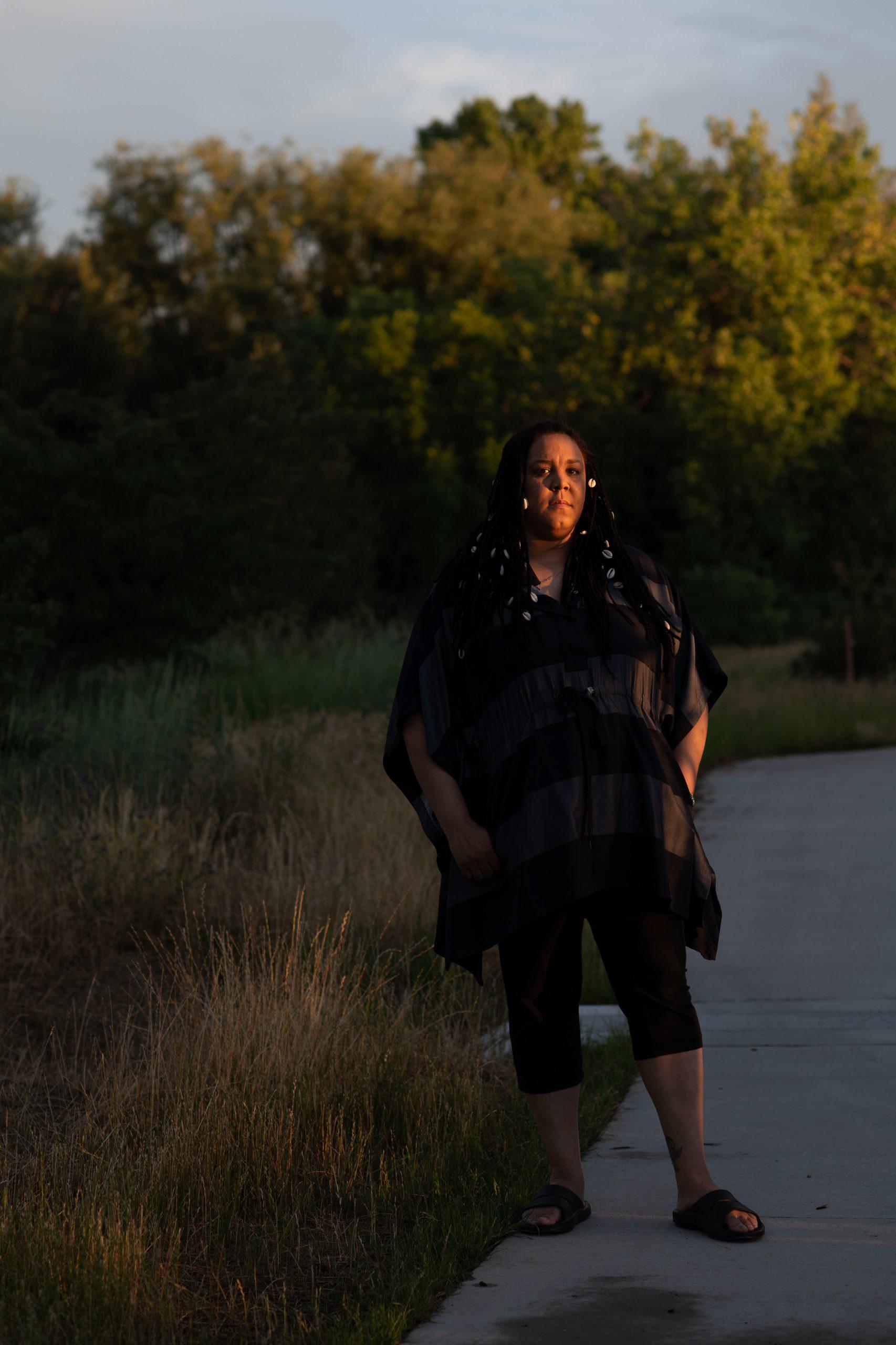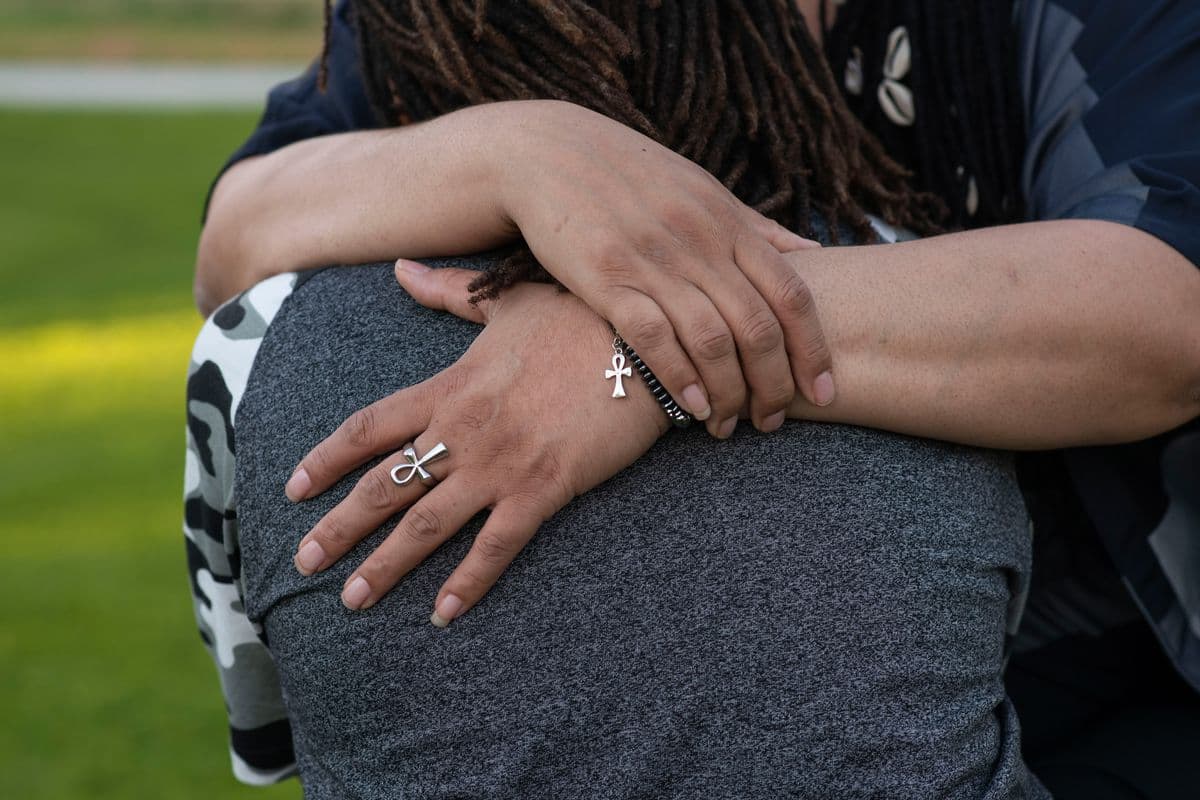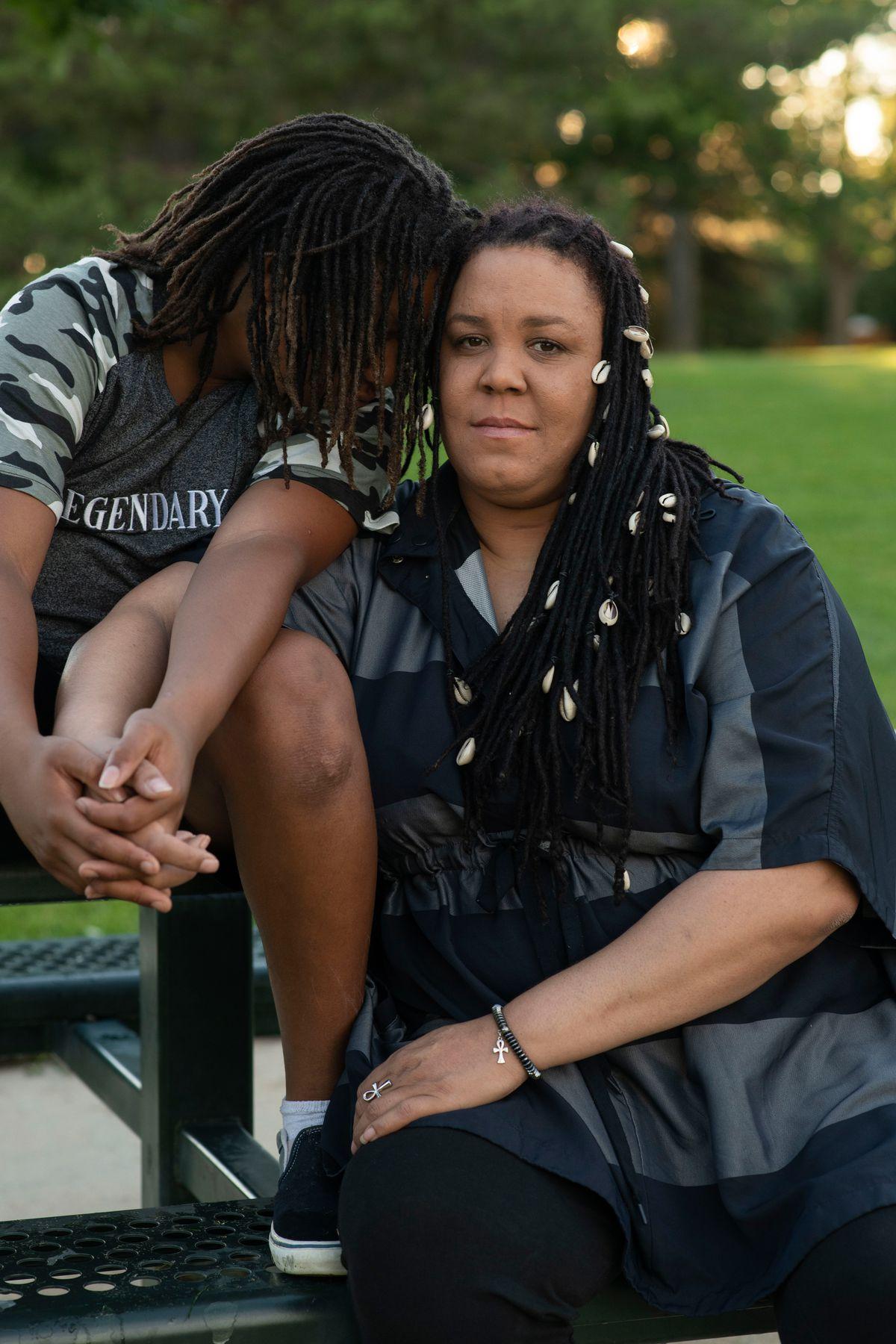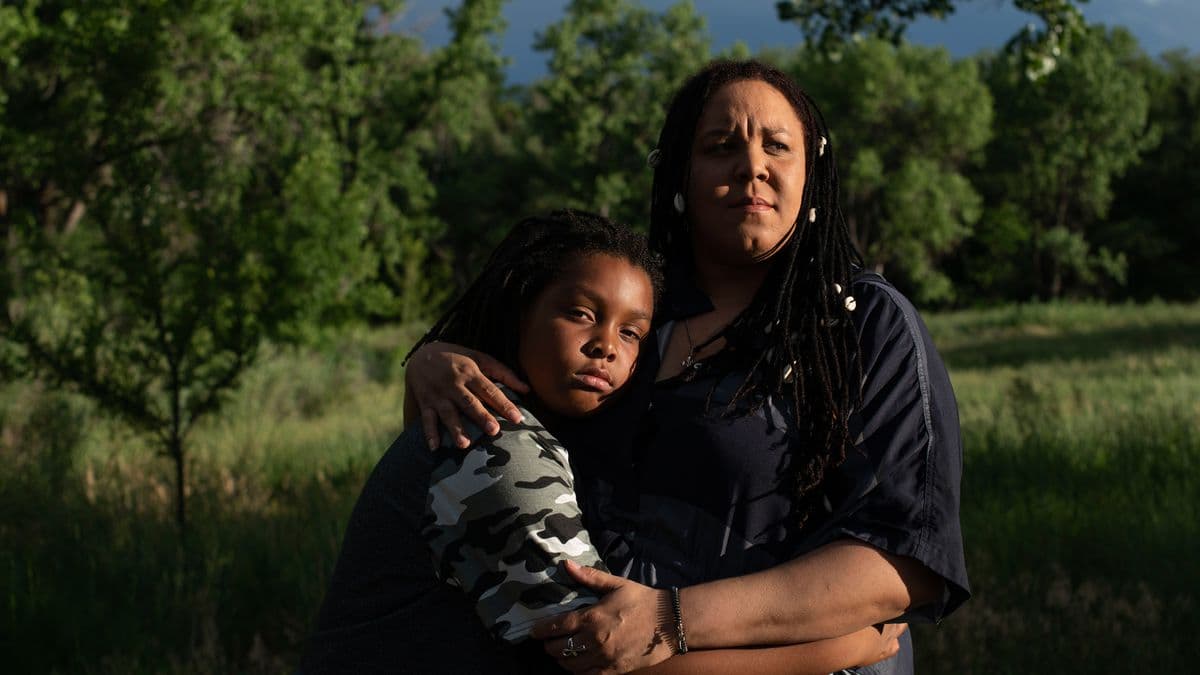By Melanie Asmar, Chalkbeat Colorado
This story was originally published by Chalkbeat, a nonprofit news organization covering public education. Sign up for their newsletters here: ckbe.at/newsletters.
Kal-El was in second grade the first time a teacher threatened to call the police on him.
His class was playing outside at recess. The teacher said it was time to go inside, and Kal-El refused. When the teacher made the threat about the police, Kal-El took off running toward the playground fence in an attempt to climb it, said his mother, Jennifer Uebelher.
"This started Kal's terror of the police," Uebelher wrote in notes she kept about his school days.
The teacher didn't end up calling the police that day. But by the end of second grade, school staff had called police on Kal-El three times, according to his mother. By the end of fifth grade in May, the 11-year-old whose parents named him after Superman, who has attention deficit hyperactivity disorder and struggles with his behavior, had at least 32 interactions with police or armed security guards at school in Denver and neighboring Jefferson County. Chalkbeat was able to confirm some of the interactions using police and school district records.
"I've had nightmares about my mom being shot, me being shot," Kal-El said recently while sitting in his backyard. "I had nightmares that the police came to the house and kept banging on the doors, and they came in and we had to hide. I've had that more than once in a night.
"I'm scared to death because I'm like, 'What are they going to do to me?'"
In a year in which high-profile incidents of police brutality sparked protests across the nation, schools have been grappling with how police should interact with students. Last summer, in the wake of the murder of George Floyd, a Black man, by a white police officer in Minneapolis, the Denver school board took a step toward reducing those interactions when it voted to remove the 18 city police officers who were stationed at some middle and high schools.
But the board's actions won't stop all police interactions. Schools can also call 911 or a separate pool of armed school district security guards -- and they do so thousands of times a year.
For students like Kal-El, the interactions can be traumatizing. As a young Black boy, he is painfully aware of the prevalence of police brutality and bias against the Black community. Chalkbeat is not using Kal-El's last name in this story to protect his privacy.
"Whenever he gets in trouble, he's like, 'Well, just let the police come and shoot me. That's what they do,'" Uebelher said. "That's a horrifying thing to hear from an 11-year-old. After 3½ years, with 32 police interactions, I can understand why he feels that way."
More than 10,000 calls
When the school board voted to remove city police, known as school resource officers, from schools, members also directed the district to "redefine school safety" with an emphasis on supporting students' mental health. In addition, the board required the district to publicly track how many times city police and armed district patrol officers are called to schools and why.
"One reason we generally want data is for public accountability, but also to put everyone on notice that we're tracking the behavior," said school board Vice President Jennifer Bacon, who as one of two Black members of the board was a driving force behind the resolution.

Data posted by Denver Public Schools this spring gave the public a first glimpse of the numbers. It showed that armed district patrol officers were called to schools 5,560 times in the 2019-20 school year, which was interrupted in March 2020 by the COVID-19 pandemic.
Denver Police Department data obtained by Chalkbeat through an open records request showed 4,785 calls from schools to police in that same school year. That includes calls answered by the 18 school resource officers, as well as calls answered by other police.
Added together with the district patrol officer calls, that means armed personnel responded to schools more than 10,300 times in 2019-20. The district had roughly 92,000 students that year.
A significant portion of the calls to both police and armed district patrol officers were for routine matters, such as alarms going off or a teacher locked out of a building.
More than a quarter of the calls to police were for potential crimes, such as assault, drug possession, and criminal mischief, though it's unclear if all of those involved students.
Some calls were in response to student behavior. District patrol officers were called 303 times for a "child in crisis," meaning a child who is behaving unsafely toward themselves or others, or whose behavior warrants immediate intervention, and 35 times for a "disobedient child."
Denver police are also sometimes called to those situations, though it's harder to know how often because the police department doesn't code calls as "child in crisis." The department did not respond to a request for an interview about those types of calls.
Bacon, a former teacher, recognizes that students' behavior can be difficult. Situations where one child is disrupting the learning of 30 others are all too real, she said. However, she said educators need less traumatic ways of managing that behavior than calling the police.
"When you're calling for a body -- and one that has a gun -- you're doing that to shut down the behavior," Bacon said. "The problem is there's a potential for a traumatizing event."
Also concerning, she said, are racial disparities in which students are interacting with police. Data shows Black students in Denver Public Schools are disproportionately referred to law enforcement for alleged crimes and code violations, and disproportionately ticketed or arrested.
While a racial breakdown is not available for Denver students who are referred to law enforcement for behavior or mental health issues, data and school district policies from across the country suggest racial disparities persist with those calls, too.
In New York City, a report by an advocacy organization found Black students and students with disabilities were overrepresented among more than 12,000 "child in crisis" police calls it analyzed. In Chicago, the school system revised its conduct policy to limit when administrators can call police, advising them to first take a student's disability or past trauma into account.
Scared, not angry
A bright child, Kal-El went to preschool and kindergarten at a small private school for gifted students. But in first grade, he was diagnosed with attention deficit hyperactivity disorder, or ADHD. Uebelher said both she and the school staff decided that Kal-El's needs were beyond the school's ability to handle and it would be better if he transferred elsewhere.
Uebelher enrolled Kal-El in a public school in Lakewood in suburban Jefferson County where the family lived. She hoped the public school system could provide Kal-El with more services. But from the beginning, his experience was colored by run-ins with the police.
In second and third grade, he had 19 interactions with police or armed security officers for behavior that involved kicking, punching, throwing things, and running out of school, according to his mother's records. Once, his mother showed up and found him handcuffed in the back of a police car. Another time, she walked into a classroom that Kal-El had torn apart to find him corralled on top of a bookshelf in a corner. She said she had to push past officers to get to him.

At first, Kal-El's doctors attributed his aggressive behavior to an adverse side effect of an increased dosage of his ADHD medication, his mother said. But once the police interactions started, "that just kicked it up a thousand times," she said.
Jeffco Public Schools spokesperson Cameron Bell said the district can't comment on specific students or verify how many times schools called the police. Chalkbeat did not independently analyze Jefferson County schools' calls to police or armed security guards. But Bell provided a general list of reasons why a school might call the police, including "out-of-control behavior that is beyond the ability of the school to manage and that puts others or self at risk for injury."
Kal-El knows his behavior can be challenging. He can get angry, frustrated, and out of control, he said. He has broken school property and run out of school buildings. In addition to ADHD, he's been diagnosed with a mood dysregulation disorder and anxiety, his mother said.
But Kal-El also knows what helps him calm down: Talking to his mom on the phone. Spending time alone in a separate room. Getting some energy out by throwing a ball or running around. Outside of school, Kal-El and his mom said he has benefitted from a type of therapy known as eye movement desensitization and reprocessing, or EMDR.
But calling the police? Kal-El said that just makes any situation worse.
"I'm not angry at the police. I'm more scared of the police," Kal-El said. "I'm more angry at the school because most of the times, yes, I am out of control and I recognize that. Sometimes they're just like, 'Well, we're going to call the police,' and it makes me more mad."
'I screamed'
One of Kal-El's most traumatic experiences with police happened in 2019, when he was in fourth grade. His mother had transferred him from Jeffco Public Schools to Denver Public Schools, where she had attended as a child. Kal-El was in a special program for students with emotional disabilities, just as he'd been for most of his time in Jeffco.
On his second day of school at Denver's Cowell Elementary, another student in the program called Kal-El a racial slur. Because of the way he reacted, the school called his mother to pick him up early, according to his mother's notes. The next day, it happened again. It continued happening the next week until one day, Kal-El ran out of the school.
Uebelher was on her way home from the school after a meeting about his special education plan when she got a call to turn around and come back. Kal-El was on the front steps of the school, banging on the doors, clearly agitated. It was around lunchtime, and Uebelher had a Tupperware container of green grapes in her car. Knowing that hunger sometimes triggered Kal-El's agitation and eating calmed him down, she set the grapes on the steps for him.
In addition to calling Uebelher, the school also called for the assistance of armed officers.
A report obtained by Chalkbeat through an open records request shows that someone at Cowell called the Denver Public Schools Department of Safety at 12:13 p.m. to report a "disobedient child" identified as Kal-El. The report says he was "not listening to staff or parents."
"No one is currently in danger," it says next to a timestamp of 12:14 p.m.
A separate Denver Police Department record obtained by Chalkbeat shows that police were also called to Cowell -- for a "disturbance"- at 12:20 p.m. It's not clear if the same person called both agencies, but the district report says the person who called for help from armed district patrol officers also referenced calling Denver police.
Uebelher estimates that a half dozen or more officers showed up. At first, she said they were just "milling about," trying to talk to Kal-El and make sure he didn't run into the street.
But when Kal-El made a sudden move toward the grapes she'd left on the steps, Uebelher said she saw the officers reach for their hips where their weapons were holstered.
"I screamed, 'Kal-El, stop or they're going to shoot you!'" Uebelher recalls. "I never thought I'd be yelling that to my fourth-grade son on the steps of an American elementary school."
The officers didn't draw their weapons, and no one was injured. But Kal-El broke down. The incident ended with Uebelher requesting an ambulance to take Kal-El to the hospital, which released him with instructions to stay home from school, according to his mother's notes. Kal-El transferred to another Denver school with even more intensive services the following week.
The department of safety report corroborates Uebelher's account. It says that Kal-El was transported to the hospital at 12:51 p.m. Though Denver police did respond, they did not write a report of the incident, said Denver Police Department spokesperson Jay Casillas. And because there is no report, any body camera footage was purged after 30 days, Casillas said.

'Hands are tied'
The principal of Cowell Elementary declined an interview with Chalkbeat because she said she wasn't principal of the school in 2019 when the incident occurred. Denver Public Schools officials declined to comment on Kal-El's specific case, citing student privacy. But they said that in situations such as these, schools have discretion about whether to call the police.
"People call law enforcement when they feel the situation has gone beyond their reach at the school level and it creates this imminent risk," said Amber Elias, the district's lead operational superintendent, who helps supervise principals. But, she added, "it's one thing to have a subjective definition of 'imminent risk' and then in the moment, it can feel very personal."
Elias said it's the district's responsibility to ensure school staff understand where the line is. To that end, the district is planning to unveil a new website this fall to help educators navigate crises. Still under construction, it features a red button that says, "Is this an emergency? Before you call 911..." A drop-down menu will give instructions for what to do in different situations, such as if a student is found with marijuana, gets into a serious fight, or is suicidal.
Rob Gould, president of the Denver Classroom Teachers Association, said educators don't want to call the police. Instead, he said, teachers want the proper support systems -- such as full-time school psychologists, social workers, and counselors, which not all Denver schools have -- to ensure students don't get so upset that their behavior becomes risky.
"Educators don't want to cause any additional trauma for the student," Gould said.
A lack of educator experience and training also likely plays a role in these situations, especially for teachers who work in programs for students with emotional disabilities. A special education teacher, Gould previously worked in such a program. Though he lasted nearly a decade, Gould said, "it's hard to get a veteran educator to do that job because it is so intense."
Amie Baca-Oehlert, president of the Colorado Education Association, echoed Gould.
"What we hear the most, and what we at the CEA have been lifting up and advocating for multiple years now, is our teachers don't have a lot of resources to turn to when we have these types of situations," she said. "Teachers' hands are tied in that they do not have a lot of options."
When it comes to students in crisis, "oftentimes what somebody needs is not a law enforcement response," Baca-Oehlert said. "They actually need a mental health response."
New measures
Last summer's resolution directed the district to reallocate the money it previously spent on school resource officers to mental health staff. But the amount -- $626,000 -- isn't enough to hire more psychologists and social workers for each of Denver's more than 200 schools.
Instead, about $400,000 will be spent on four new central office staff members who could be deployed to schools, according to a plan presented to the school board. The new staff would help with a variety of things, including reducing racial disparities in discipline, preventing suspensions, and responding to reports of sexual assault or students who are suicidal.
About $75,000 is slated to go toward engaging parents and students in helping to revise the district's discipline matrix, which dictates when schools must call the police and when they have discretion. That work is set to happen next school year, Elias said.
Another $175,000 is set to be spent on a new partnership with the Mental Health Center of Denver that would have mental health providers respond alongside armed district patrol officers. The patrol officers work around the clock, and the co-responder model would only be deployed on nights and weekends when school psychologists and counselors are not available.
The partnership would be different from a highly praised, high-profile city program that replaces police officers altogether with mental health providers and paramedics who respond to crisis calls. Bacon, the school board vice president who pushed for the resolution, said she wonders what it would look like to bring that program -- called the Support Team Assisted Response, or STAR, program -- into Denver Public Schools.
"We need a whole different type of people for this," Bacon said. "We need a de-escalation squad that doesn't have a badge and a gun."
The district isn't getting such a squad, but it does plan to increase the number of armed district patrol officers from 20 to 25 next year, said Melissa Craven, the district's interim deputy chief of support services. That expansion will be funded by a separate pot of money.
In addition, the district is working with the city to grant those officers expanded authority to write tickets to students for low-level municipal code violations, Craven said. The details are still being worked out, but a district presentation gives a few examples of the types of violations, including marijuana possession, trespassing, and vandalism. Patrol officers still wouldn't be able to make arrests or initiate 72-hour hospitalizations for students in mental health crises.
The move may increase the likelihood that a student will interact with an armed district officer at the same time their likelihood of interacting with a police officer is decreasing. But Craven said that's not a bad thing. District patrol officers have students' best interest at heart, she said, in addition to training in nonviolent crisis intervention and trauma-informed practices.
"Our officers, whether campus security officers or patrol officers, come to this work with a different lens," Craven said. "They are truly here to support our students."
That gives Bacon pause. She said the district needs to ensure it's not de facto replacing one law enforcement presence with another. "If it wasn't clear to folks our intention with this resolution, then we need to go back and be sure those intentions are actually met," she said.
When Chalkbeat told Bacon about what happened to Kal-El on the steps of his elementary school, she said she began to shake.
"It shouldn't have happened," she said. "Grapes. I'll never forget that for the rest of my life."

Lasting fear -- and hope for the future
Kal-El and his mother hope the district's efforts are sincere. Uebelher said she has seen her son go from an eager student who was learning Spanish and built a digestive system out of marbles to a pre-teen who can't do division and struggles with writing by hand. When he went to public school, he was a grade ahead academically, and now he's a year and a half behind, she said.
But more than academic consequences, it's the fear she sees in her child that worries her. Although Uebelher said many of the officers who interacted with Kal-El at school were kind and compassionate, their mere presence was terrifying for him.
She remembers once finding Kal-El cowering under a table while an officer stood with his hands on his belt. Uebelher crawled under the table and looked up. The officer was so tall that she said from Kal-El's vantage point, it looked like his bald head touched the ceiling.
The officer asked her why Kal-El was so afraid of the police.
Uebelher said she remembers thinking, "Have you seen yourself?"
"You've got a gun, you've got mace, you've got a taser," Uebelher said. "It was more the psychological part of it that was so bad for Kal-El.
"We try to teach our kids that bad guys get the police called on them. As a child, it's like, 'Well, they're here for me. I must be a bad guy.' ... He internalized that."
Kal-El hopes no other student ever has to.
"I don't want this to happen to anybody else," he said.
Chalkbeat is a nonprofit news site covering educational change in public schools.














